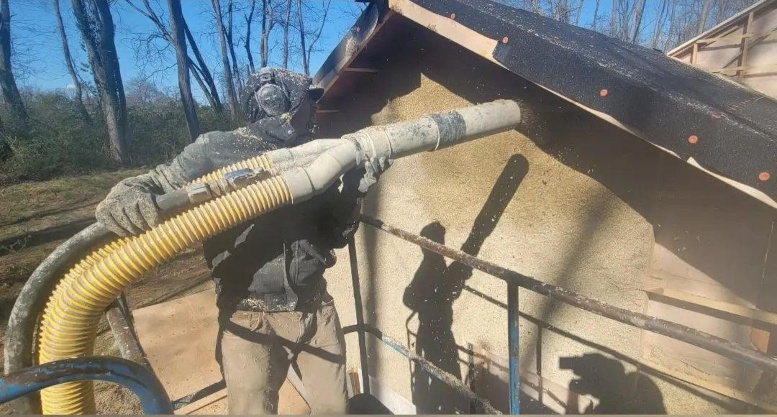By Steve Allin
If the COVID-19 pandemic was, as U.N Secretary-General Antonio António Guterres said, “like an X-ray revealing fractures in the fragile skeleton of the societies we have built,” and if climate change is a major cause of the fractures, then the invasion of Ukraine by Russia is like the painkillers being removed from this malaise.
All issues of energy dependence, food security and housing crisis were all previously present but in a somewhat distant form, vaguely felt through the haze of rising fuel prices, overstocked supermarkets and images of strangers on the pavements. As we now contemplate the impending serious problems heading our way, we urgently need to identify solutions as quickly as possible.
So how do we address these seemingly unconnected issues? I suggest that they are not at all unconnected and that the solutions could be found in a single plan based on industrial hemp.
Food security
Addressing food security is of paramount importance. Despite the increasing numbers of stories of farmers protesting unsustainable market prices, we have all gone along with the concept that food should be cheap and endlessly supplied. It is now dawning on us that many of the foods we consider basics, such as bread and the food we feed our other food sources, especially animals for meat products, originates in either Russia or Ukraine!
With the flow of both food and fuel supplies disrupted by the horrific invasion of Ukraine, the costs of this unsustainable system are impacting food production everywhere else.
Many people are aware of hemp foods nowadays, but there are still many ways that hemp can be used for the transition to a lower meat diet and provide us with a highly nutritious meal.
The right crops
To address the issues of increased nitrate costs and fertility loss of much agricultural land in the West, we need crops that do not require large amounts of fertilizer and might improve the quality of the land for future crops such as industrial hemp. Hemp could be grown with human waste, which we are currently literally flushing down the toilet.
Though this waste would need to be filtered for microplastics and toxic elements that might be present, the processing of animal and human waste with anaerobic digesters can provide not only a completely safe fertilizer but also energy in the form of much-needed gas.
Hemp also provides an ideal crop to begin the return to tillage farming currently being promoted by governments as a reaction to the war in Ukraine, as it’s extremely fast-growing, smothers competing weeds, reduces herbicide use, and improves the land for future harvests of especially winter wheat or barley or green cover crops sown immediately after the hemp is harvested.
Healthy housing
Providing housing for our young populations as they attempt to start their study or careers in our cities, or the wish of young families to have a comfortable first home does not seem possible at present as there seem to be housing shortages in most cities. The fact so many of the available premises are also energy inefficient and either expensive or unhealthy to live in is a sad reflection of current building standards.

Meet leading practitioners at the 10th International Hemp Building Symposium, Lacapelle Marival, France, Oct. 11-12, 2022.
Materials extracted from the hemp plant can be used as a natural fiber alternative to mineral wool and plastic foam insulation products or as aggregate in hempcrete. These materials have a combination of positive behaviors, buffering the heat changes inside and outside a building while regulating humidity. This is especially true of hempcrete, which can easily be formed to provide a seamless fire-proof thermal blanket to a structure that resists mold and has no toxic off-gassing.
These breathing, heat-storing and insulating materials are now being used to provide healthy upgrades to existing structures, or new buildings all over the world. Pre-formed into blocks, particle board or panels, hemp-based materials are also being incorporated into modular housing systems now.
Investment needed
Addressing this range of issues with the cultivation of a single plant might sound ideal, but without the essential primary processing facility, there is no market for the raw material. The process of decortication and material separation or the breaking of the straw to extract the bast fibers and core particles, known as hurds, in a marketable form is not possible until there are factories to do the job. This would require a site in the center of the most suitable tillage area in a region to service a community of farmers growing hemp as part of a sustainable crop rotation system.
It is possible to have a factory where a bale of hemp enters at one end and bricks or whole houses of modular panels emerge from the other end. The factory would need an investment of €3,000,000- €30,000,000 depending on how many additional products were to be manufactured on the same site. This is nothing if we include in the financial balance the employment of 8-60 people with additional labor created by product delivery and installation.
Add to this both the carbon sequestration and reduction calculated for the materials, and the whole process would then be measured as “net zero” for emissions, much like many of the hemp homes being built internationally at the moment.
In times of an “emergency,” basic requirements such as food and shelter become paramount. And if there are good new systems for meeting those essential needs, we should do all we can to invest in this vital crop so as to harvest these opportunities.
Steve Allin is a consultant, teacher and the author of “Building with Hemp” (2005, 2012) and “Hemp Buildings 50 International Case Studies” (2021). An advisor to HempToday, Allin is the director of the International Hemp Building Association.


